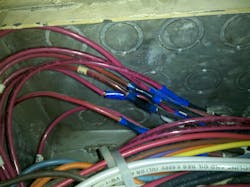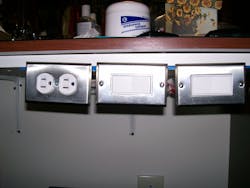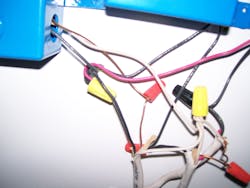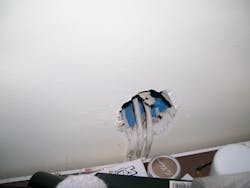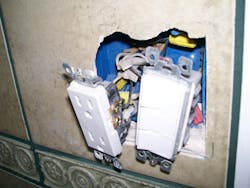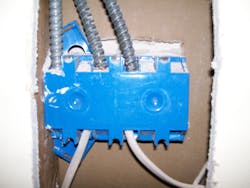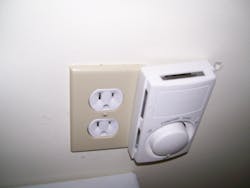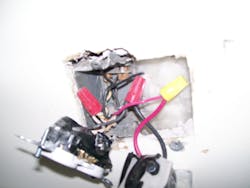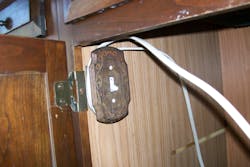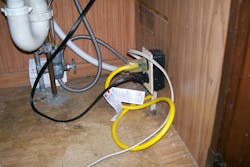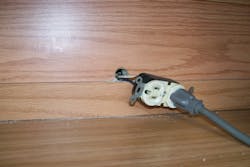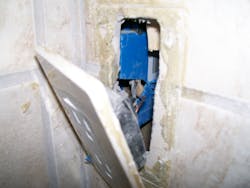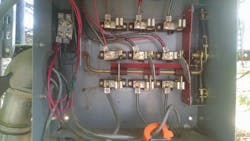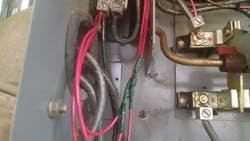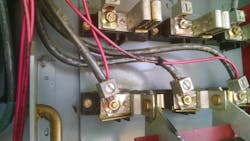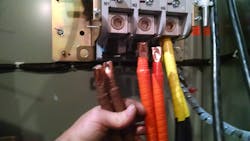The world is full of resourceful people — people whom we often admire for their ingenuity. Inventors, engineers, and architects who think outside the box can create innovations that blow our minds with their advanced technological knowledge. On the other end of the spectrum is the “do-it-yourselfer” who can fix a garden hose with a roll of duct tape, grow tomato plants out of old buckets, and hang a garbage can lid under a bird feeder to keep the squirrels out. Unfortunately, this same type of person often attempts DIY electrical work — whether it involves hanging a ceiling fan or rewiring an entire house.
As electricians, we sometimes find ourselves straddling both worlds. We are well-educated and licensed professionals who follow established codes and standards practices. Nevertheless, we often feed our families by correcting the mistakes of others who are either poorly trained or not trained at all. For some reason, there are still people out there who think an electrician's job is as simple as “black and white make a light.” It’s not until they see sparks, flames, or smell something burning that they finally call in the professionals.
Throughout my 40-plus years in the electrical industry, I have encountered all types of frightening finds. Some of these scary situations were created by the homeowners themselves; others were left by residential kitchen and bath contractors who cut corners and opted to perform the plumbing and electrical work without permits. It has always bothered me to see such failed attempts, knowing that a homeowner paid these contractors in good faith and believed the work was done professionally and to Code. What makes me cringe the most, however, is when I encounter shoddy work performed by licensed electrical contractors who take short cuts or try to perform work that requires a certain level of skills, tools, and equipment that is way out of their league.
I have hundreds of stories and thousands of pictures of some of the shocking scenarios I have encountered along my journey as an electrical professional. As you can imagine, it was difficult to narrow down my list for this article, so perhaps I can share more lessons learned with you in the future. For now, sit back, relax, and enjoy some of my most “Frightening Electrical Finds.”
Now retired after 40 years in the industry, John Kostick is a licensed master electrician in New Jersey and Delaware. He is also a licensed electrical instructor in New Jersey, a certified fire instructor, and a volunteer firefighter. He can be reached at [email protected]. Also read his recent article, “A Pinch of Peril.”
The House of Horrors
I remember the day like it was yesterday. The fire department I was a member of had responded to two calls in as many days to the same residence for "the smell of something electrical burning.” The first call involved the meltdown of a power strip laying on the wooden floor of the master bedroom; the second call stemmed from a burning smell coming from the dishwasher. Having the fire department at her house two days in a row freaked the homeowner out so much that she was afraid to even sleep there. She immediately called me to ask if I’d come out, have a look at her wiring, and find out what was going on.
After meeting with the homeowner, she explained how she had arrived home around midnight to find her garage door opener didn’t work when she pressed the button. When she entered the house, she smelled something burning in the bedroom and saw smoke. Next, she took me to the kitchen and explained that her dishwasher had suddenly stopped working as well — and that she also smelled burning in the kitchen.
I started my investigation by removing the panel cover and checking the breakers and the voltage on the phases. I soon discovered that the voltage on the phases was fluctuating as the homeowner went around the house, turning on light switches and such. It quickly became obvious that she had lost a neutral. To further complicate the issue, there was no earth or water pipe ground.
My initial diagnosis was that when she had come home and hit the button for the garage door opener, it didn’t operate because the load caused the voltage to swing to the other phase, thus sending too much voltage to the power strip and causing it to fail and melt. The same thing happened with the dishwasher, but the motor cooked due to low voltage to the unit. Lost neutrals can cause much bigger problems than making your lights flicker!
After discussing my findings with the customer, she contacted her insurance company, which agreed to let me examine everything electrical in the house to determine if any further damage had occurred from the fluctuating voltages (including electronics, dimmers, and the HVAC system). I can’t remember exactly what prompted me to remove the first device. Perhaps it was the exposed wiring in her changing room or the fact that she told me she had hired a “handyman” to complete various types of work in her home (including electrical), but there were never any permits or inspections required that she knew of. The minute I opened the first box, my journey down the rabbit hole began.
To be honest, I found so many things wrong that calling them “Code violations” doesn’t even scratch the surface. Not only were many of the mistakes I found horrifying, but they were also outright examples of a lack of common sense — some people know just enough to be dangerous. Since I mentioned the changing room earlier, let’s start our journey there.
An initial look at the switches and receptacle mounted to the bottom of the homeowner’s changing room counter showed individual wires sticking out of the back of the boxes (Photo 1). Upon closer examination, I found the exposed wiring and splices (Photo 2). When I moved some of the items from the top of the counter, I discovered that the NM cables poked out of a hole in the wall above it and were sandwiched between the counter and the wall to which they were spliced openly below it (Photo 3).
Next, I checked the bathroom to see what surprises awaited me. An innocent-looking 2-gang assembly with a triple switch and a receptacle first caught my attention. When I pulled them out to check the splices (Photo 4), however, I realized it was actually a 3-gang plastic box with multiple cables entering it, including 2 BX cables (Photo 5). An oversized hole had been cut into the wallboard, and someone had laid tile in an attempt to cover the hole and the third gang of the box. But, hey, at least there was plenty of box!
Next, it was time to enter the bedroom, where I first noticed a line voltage thermostat for the electric baseboard heat . As you can see, it looked peculiar (Photo 6). Here, I discovered the side of a 1-gang metal box had been removed, and the thermostat was being held in place by the wires and one wall anchor with a wallboard screw (Photo 7). This was an example of not having enough box!
By now, I realized that each device I removed was going to be as bad or worse than the last one. Focusing my attention on a 1-gang switch at the doorway, I removed the cover and saw the telltale wallboard screws anchoring the device — but anchored to what? I removed the screws and found an example of a new streamlined method of installing devices (Photo 8). Boxes? We don’t need no stinking boxes!
At yet another location, the installer almost got it right (Photo 9). Here, he or she installed a 4-inch metal box with a 2-gang raised adapter but failed miserably with the grounding. But again, at least there was a box!
Next came the countertop receptacles. Seeing none, I rolled up the little wooden doors where the backsplash would be and found some plug mold strips. My first thought was that it was highly unlikely they were GFCI protected (they weren’t). When I snapped the cover off, I shook my head in disbelief. I’ve installed many of these strips, so I’m very aware of how little room there is for splices even with the larger entrance fittings. I’ve even seen where the solid copper wires were joined with barrel crimp connectors, of which I have never been a fan. Imagine how disgusted I was to discover that the strips were fed from the back, and the solid copper wires were joined using a telephone splice with no connectors or insulation! I have no idea how this didn’t blow up (Photo 13).
Although I could keep going on and on about this house of horrors, I’ll end with this last image (Photo 14). Pictured here is a bathroom receptacle. I can only assume that the wires were too short to move the box out of the corner, but that didn’t stop this "creative" installer from putting the device in the wall. Why move a box when you can just cut the side of it open and extend the conductors to reach the device? But what about screwing the device into the box where it belongs so that it's supported? No worries — just screw the cover to the device and use the tile adhesive to hold it all in place. Add a little grout, and it looks perfect!
The Misfit Manual Transfer Switch
While inspecting some equipment for a customer, I came across this manual transfer switch (Photo 15). Chances are this was originally installed by a qualified electrician. As most of us know, some service technicians (who know just enough to be dangerous) make modifications simply to make things work. Although these are typically intended to be “temporary” fixes, it seems like there is never enough time or opportunity to do it correctly to begin with or to go back and complete a permanent installation.
Peering inside this switch, you can see that the installer must have only had a spool of red wire on the truck — and a roll of green tape as well. Look closer, and you'll see some water dripping from the original ground wire installed in the lug (Photo 16). It’s interesting to note that the ground lug is deteriorating — likely, there is a less-than-adequate connection being made through the corrosion. If you look even more closely, you'll notice two red wires stuffed under the phase A and phase C on the load side. How nice that the installer took the time to place a zip tie on one of them to shape it in with one of the larger conductors.
Now comes the fun part. If you look at the wire from phase C, you can clearly see that when this equipment was installed, it got caught under the switch blade on phase A and short circuited (Photo 17). There's no way the installers could not have known that they crossed phases! The loud bang would have been the first indication, which is usually followed by a burnt electrical smell and puff of smoke. To walk away and leave things in this state is beyond comprehension. As I said earlier, other electricians or service technicians had to have noticed this over the years, but not one of them took the time to inform the customer of this unsafe condition or repair it.
Word to the wise: Always install equipment and conductors as if they are permanent because the chance to go back and do it right may never come.
When “Tested” Can’t Be “Trusted”
Almost every piece of material that electrical professionals use has been tested and listed for the purpose for which it was designed. We then use our skills and knowledge to install these components in a workman-like manner, double checking our work before we energize anything.
Professional inspectors examine our work to ensure these components are installed correctly, according to their design and used for their intended purpose. What helps govern this system is the fact that inspectors who are also electrical contractors may not perform work in the towns where they perform inspections, thus eliminating the chance of inspecting their own work.
On this particular job, I was installing a transfer switch. Inside the cabinet was a label with the build number and inspection details (Photo 18). In this case, the transfer switch happened to be wired by “FPL.” However, it was also inspected by “FPL.”
After mounting the switch on the wall and running my conduits to it, I was ready to terminate my wiring. As I was installing conductors in the top terminals, the factory-wired conductors literally fell out of the lugs that they were terminated under. First it was one set, then another, and finally the last pair.
As you can see in Photo 19, the lugs had not been loosened at all. At that moment, I cursed this person known as “FPL” because he or she had created a situation that would have killed me had I energized the switch. Secondly, if the conductors didn’t fall out while I was working on them, they would have fallen out eventually under their own weight and possibly grounded out against the cabinet.
The moral of this story: Never assume that just because equipment is listed, assembled under supervised conditions, and tested before it leaves the plant that it can be trusted to be safe to install and energize. Always double check the work of others to protect yourself from a dangerous situation. In this case, it wasn’t what another electrician did wrong; it was the technician in a manufacturing facility.
About the Author
John Kostick
Master Electrician
Kostick is a licensed master electrician in New Jersey and Delaware and has worked in the industry for 37 years. He is also a licensed electrical instructor in New Jersey and a certified fire instructor.
